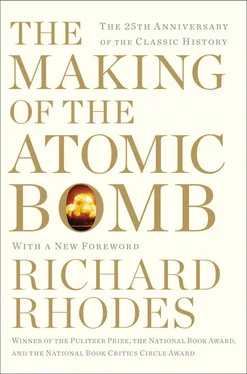In the summer of 1922 the rate of exchange in Germany sank to 400 marks to the dollar. It fell to 7,000 to the dollar at the beginning of January 1923, the truly terrible year. One hundred sixty thousand in July. One million in August. And 4.2 trillion marks to the dollar on November 23, 1923, when adjustment finally began. Banks advertised for bookkeepers good with zeros and paid out cash withdrawals by weight. Antique stores filled to the ceiling with the pawned treasures of the bankrupt middle class. A theater seat sold for an egg. Only those with hard currency—mostly foreigners—thrived at a time when it was possible to cross Germany by first-class railroad carriage for pennies, but they also earned the enmity of starving Germans. “No, one did not feel guilty,” the visiting Englishman crows, “one felt it was perfectly normal, a gift from the gods.” 33
The German physicist Walter Elsasser, who later emigrated to the United States, worked in Berlin in 1923 during an interlude in his student years; his father had agreed to pay his personal expenses. He was no foreigner, but with foreign help he was able to live like one:
In order to make me independent of [inflation], my father had appealed to his friend, Kaufmann, the banker from Basle, who had established for me an account in American dollars at a large bank…. Once a week I took half a day off to go downtown by subway and withdrew my allowance in marks; and it was more each time, of course. Returning to my rented room, I at once bought enough food staples to last the week, for within three days, all the prices would have risen appreciably, by fifteen percent, say, so that my allowance would have run short and would not have permitted such pleasures as an excursion to Potsdam or to the lake country on Sundays…. I was too young, much too callous, and too inexperienced to understand what this galloping inflation must have meant—actual starvation and misery—to people who had to live on pensions or other fixed incomes, or even to wage earners, especially those with children, whose pay lagged behind the rate of inflation. 34
So must Szilard have lived, except that no one recalls ever seeing him cook for himself; he preferred the offerings of delicatessens and cafés. He would have understood what inflation meant and some of the reasons for its extremity. But though Szilard was preternaturally observant—“During a long life among scientists,” writes Wigner, “I have met no one with more imagination and originality, with more independence of thought and opinion”—his recollections and his papers preserve almost nothing of these Berlin days. 35Germany’s premier city at the height of its postwar social, political and intellectual upheaval earns exactly one sentence from Szilard: “Berlin at that time lived in the heyday of physics.” That was how much physics, giving extraordinary birth during the 1920s to its modern synthesis, meant to him. 36
* * *
Four years of study usually preceded a German student’s thesis work. Then, with a professor’s approval, the student solved a problem of his own conception or one his professor supplied. “In order to be acceptable,” says Szilard, it “had to be a piece of really original work.” 37If the thesis found favor, the student took an oral examination one afternoon and if he passed he was duly awarded a doctorate.
Szilard had already given a year of his life to the Army and two years to engineering. He wasted no time advancing through physics. In the summer of 1921 he went to Max von Laue and asked for a thesis topic. Von Laue apparently decided to challenge Szilard—the challenge may have been friendly or it may have been an attempt to put him in his place—and gave him an obscure problem in relativity theory. “I couldn’t make any headway with it. As a matter of fact, I was not even convinced that this was a problem that could be solved.” 38Szilard worked on it for six months, until the Christmas season, “and I thought Christmastime is not a time to work, it is a time to loaf, so I thought I would just think whatever comes to my mind.”
What he thought, in three weeks, was how to solve a baffling inconsistency in thermodynamics, the branch of physics that concerns relationships between heat and other forms of energy. There are two thermodynamic theories, both highly successful at predicting heat phenomena. One, the phenomenological, is more abstract and generalized (and therefore more useful); the other, the statistical, is based on an atomic model and corresponds more closely to physical reality. In particular, the statistical theory depicts thermal equilibrium as a state of random motion of atoms. Einstein, for example, had demonstrated in important papers in 1905 that Brownian motion—the continuous, random motion of particles such as pollen suspended in a liquid—was such a state. 39But the more useful phenomenological theory treated thermal equilibrium as if it were static, a state of no change. That was the inconsistency.
Szilard went for long walks—Berlin would have been cold and gray, the grayness sometimes relieved by days of brilliant sunshine—“and I saw something in the middle of the walk; when I came home I wrote it down; next morning I woke up with a new idea and I went for another walk; this crystallized in my mind and in the evening I wrote it down.” 40It was, he thought, the most creative period of his life. “Within three weeks I had produced a manuscript of something which was really quite original. But I didn’t dare to take it to von Laue, because it was not what he had asked me to do.”
He took it instead to Einstein after a seminar, buttonholed him and said he would like to tell him about something he had been doing.
“Well, what have you been doing?” Szilard remembers Einstein saying. 41
Szilard reported his “quite original” idea.
“That’s impossible,” Einstein said. “This is something that cannot be done.”
“Well, yes, but I did it.”
“How did you do it?”
Szilard began explaining. “Five or ten minutes” later, he says, Einstein understood. After only a year of university physics, Szilard had worked out a rigorous mathematical proof that the random motion of thermal equilibrium could be fitted within the framework of the phenomenological theory in its original, classical form, without reference to a limiting atomic model—“and [Einstein] liked this very much.”
Thus emboldened, Szilard took his paper—its title would be “On the extension of phenomenological thermodynamics to fluctuation phenomena”—to von Laue, who received it quizzically and took it home. “And next morning, early in the morning, the telephone rang. It was von Laue. He said, ‘Your manuscript has been accepted as your thesis for the Ph.D. degree.’” 42
Six months later Szilard wrote another paper in thermodynamics, “On the decrease of entropy in a thermodynamic system by the intervention of intelligent beings,” that eventually would be recognized as one of the important foundation documents of modern information theory. 43By then he had his advanced degree; he was Dr. Leo Szilard now. He experimented with X-ray effects in crystals, von Laue’s field, at the Kaiser Wilhelm Institute for Chemistry in Dahlem until 1925; that year the University of Berlin accepted his entropy paper as his Habilitationsschrift , his inaugural dissertation, and he was thereupon appointed a Privatdozent , a position he held until he left for England in 1933. 44
One of Szilard’s sidelines, then and later, was invention. Between 1924 and 1934 he applied to the German patent office individually or jointly with his partner Albert Einstein for twenty-nine patents. Most of the joint applications dealt with home refrigeration. 45“A sad newspaper story… caught the attention of Einstein and Szilard one morning,” writes one of Szilard’s later American protégés: “It was reported in a Berlin newspaper that an entire family, including a number of young children, had been found asphyxiated in their apartment as a result of their inhalation of the noxious fumes of the [chemical] that was used as the refrigerant in their primitive refrigerator and that had escaped in the night through a leaky pump valve.” 46Whereupon the two physicists devised a method of pumping metallicized refrigerant by electromagnetism, a method that required no moving parts (and therefore no valve seals that might leak) except the refrigerant itself. 47A.E.G., the German General Electric, signed Szilard on as a paid consultant and actually built one of the Einstein-Szilard refrigerators, but the magnetic pump was so noisy compared to even the noisy conventional compressors of the day that it never left the engineering lab.
Читать дальше












